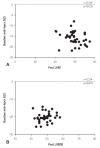Predicting Left Ventricular Dysfunction after Surgery in Patients with Chronic Mitral Regurgitation: Assessment of Myocardial Deformation by 2-Dimensional Multilayer Speckle Tracking Echocardiography
- PMID: 27014352
- PMCID: PMC4805566
- DOI: 10.4070/kcj.2016.46.2.213
Predicting Left Ventricular Dysfunction after Surgery in Patients with Chronic Mitral Regurgitation: Assessment of Myocardial Deformation by 2-Dimensional Multilayer Speckle Tracking Echocardiography
Abstract
Background and objectives: The development of postoperative left ventricular (LV) dysfunction is a frequent complication in patients with chronic severe mitral valve regurgitation (MR) and portends a poor prognosis. Assessment of myocardial deformation enables myocardial contractility to be accurately estimated. The aim of the present study was to evaluate the predictive value of preoperative regional LV contractile function assessment using two-dimensional multilayer speckle-tracking echocardiography (2D MSTE) analysis in patients with chronic severe MR with preserved LV systolic function.
Subjects and methods: Forty-three consecutive patients with chronic severe MR with preserved LV systolic function scheduled for mitral valve replacement (MVR) or MV repair were prospectively enrolled. Serial echocardiographic studies were performed before surgery, at 7 days follow-up, and at least 3 months follow-up postoperatively. The conventional echocardiographic parameters were analyzed. Global longitudinal strain (GLS) was obtained quantitatively by 2D MSTE.
Results: The mean age of patients was 51.7±14.3 years and 25 (58.1%) were male. In receiver-operating characteristic curve analysis, the most useful cutoff value for discriminating postoperative LV remodeling in severe MR with normal LV systolic function was -20.5% of 2D mid-layer GLS. Patients were divided into two groups by the baseline GLS -20.5%. Preoperative GLS values strongly predicted postoperative LV remodeling or LV dysfunction. The postoperative degree of decrease in LV end-diastolic dimension might be an additive predictive factor.
Conclusion: STE can be used to predict a decrease in LV function after MVR in patients with chronic severe MR. This promising method could be of use in the clinic when trying to decide upon the optimum time to schedule surgery for such patients.
Keywords: Echocardiography; Mitral valve annuloplasty; Mitral valve annulus repair; Mitral valve insufficiency; Mitral valve regurgitation.
Conflict of interest statement
The authors have no financial conflicts of interest.
Figures




Similar articles
-
Chronic mitral regurgitation: a pilot study to assess preoperative left ventricular contractile function using speckle-tracking echocardiography.J Am Soc Echocardiogr. 2009 Jul;22(7):831-8. doi: 10.1016/j.echo.2009.04.016. Epub 2009 Jun 7. J Am Soc Echocardiogr. 2009. PMID: 19505795
-
Assessment of longitudinal myocardial mechanics in patients with degenerative mitral valve regurgitation predicts postoperative worsening of left ventricular systolic function.J Am Soc Echocardiogr. 2014 Jun;27(6):627-38. doi: 10.1016/j.echo.2014.02.008. Epub 2014 Apr 13. J Am Soc Echocardiogr. 2014. PMID: 24735653
-
Effects of increased left ventricular wall thickness on the myocardium in severe aortic stenosis with normal left ventricular ejection fraction: Two- and three-dimensional multilayer speckle tracking echocardiography.Echocardiography. 2017 Apr;34(4):511-522. doi: 10.1111/echo.13474. Epub 2017 Mar 23. Echocardiography. 2017. PMID: 28332215
-
Global longitudinal strain to predict left ventricular dysfunction in asymptomatic patients with severe mitral valve regurgitation: literature review.Neth Heart J. 2020 Feb;28(2):63-72. doi: 10.1007/s12471-019-01318-8. Neth Heart J. 2020. PMID: 31410717 Free PMC article. Review.
-
[The best of valvular heart disease in 2006].Arch Mal Coeur Vaiss. 2007 Jan;100 Spec No 1:19-28. Arch Mal Coeur Vaiss. 2007. PMID: 17405561 Review. French.
Cited by
-
Repair versus replacement of mitral valves in cases of severe rheumatic mitral stenosis: mid-term clinical outcomes.J Thorac Dis. 2019 Sep;11(9):3951-3961. doi: 10.21037/jtd.2019.08.101. J Thorac Dis. 2019. PMID: 31656669 Free PMC article.
-
Prognostic value of left ventricular global longitudinal strain in mitral regurgitation: a systematic review.Heart Fail Rev. 2023 Mar;28(2):465-483. doi: 10.1007/s10741-022-10265-3. Epub 2022 Jul 28. Heart Fail Rev. 2023. PMID: 35900680
-
Speckle tracking echocardiography in primary mitral regurgitation: should we reconsider the time for intervention?Heart Fail Rev. 2022 Jul;27(4):1247-1260. doi: 10.1007/s10741-021-10100-1. Epub 2021 Apr 7. Heart Fail Rev. 2022. PMID: 33829389 Free PMC article. Review.
-
Role of Speckle Tracking Echocardiography to Predict Left Ventricular Dysfunction Post Mitral Valve Replacement Surgery for Severe Mitral Regurgitation.J Saudi Heart Assoc. 2022 Nov 2;34(3):157-162. doi: 10.37616/2212-5043.1315. eCollection 2022. J Saudi Heart Assoc. 2022. PMID: 36447601 Free PMC article.
-
Regional Left Ventricular Myocardial Dysfunction After Cardiac Surgery Characterized by 3-Dimensional Strain.Anesth Analg. 2019 May;128(5):854-864. doi: 10.1213/ANE.0000000000003785. Anesth Analg. 2019. PMID: 30896605 Free PMC article.
References
-
- Joint Task Force on the Management of Valvular Heart Disease of the European Society of Cardiology (ESC); European Association for Cardio-Thoracic Surgery (EACTS) Vahanian A, et al. Guidelines on the management of valvular heart disease (version 2012) Eur Heart J. 2012;33:2451–2496. - PubMed
-
- Nishimura RA, Otto CM, Bonow RO, et al. 2014 AHA/ACC guideline for the management of patients with valvular heart disease: executive summary: a report of the American College of Cardiology/American Heart Association Task Force on Practice Guidelines. J Am Coll Cardiol. 2014;63:2438–2488. - PubMed
-
- Witkowski TG, Thomas JD, Debonnaire PJ, et al. Global longitudinal strain predicts left ventricular dysfunction after mitral valve repair. Eur Heart J Cardiovasc Imaging. 2013;14:69–76. - PubMed
-
- Enriquez-Sarano M, Avierinos JF, Messika-Zeitoun D, et al. Quantitative determinants of the outcome of asymptomatic mitral regurgitation. N Engl J Med. 2005;352:875–883. - PubMed
-
- Rosenhek R, Rader F, Klaar U, et al. Outcome of watchful waiting in asymptomatic severe mitral regurgitation. Circulation. 2006;113:2238–2244. - PubMed
LinkOut - more resources
Full Text Sources
Other Literature Sources
Research Materials
Miscellaneous

